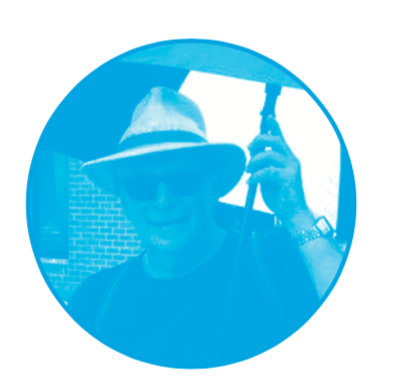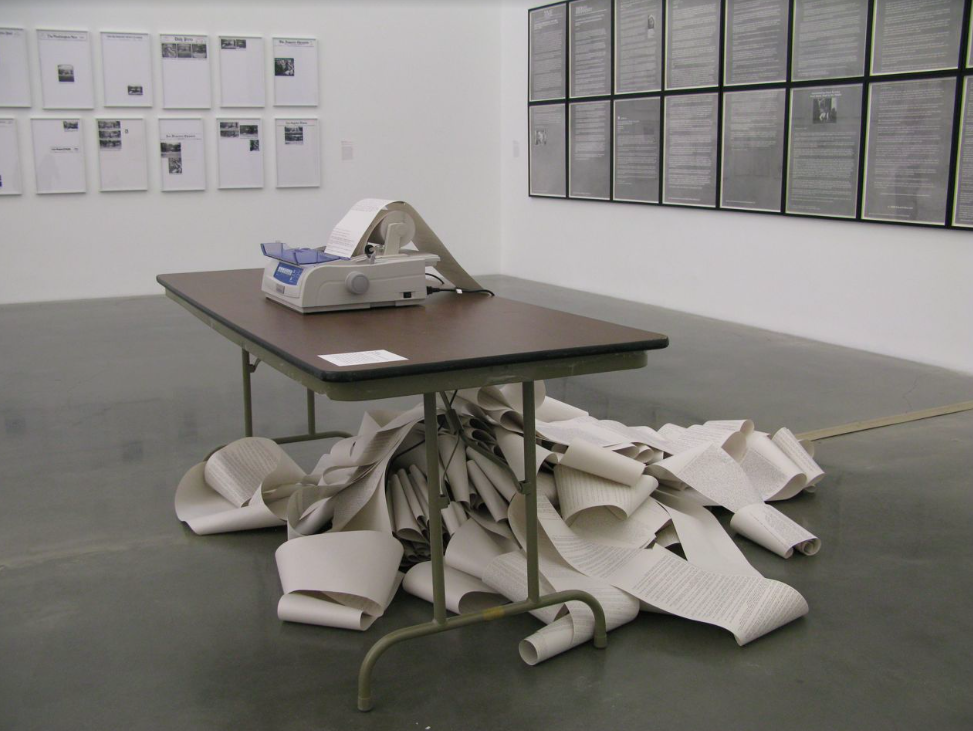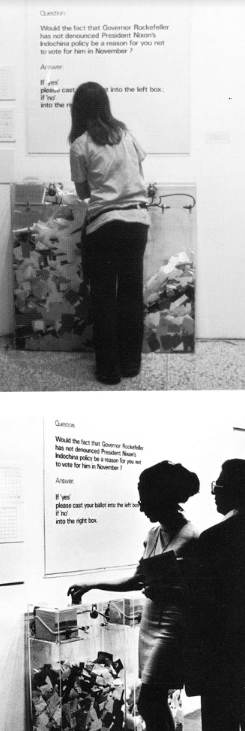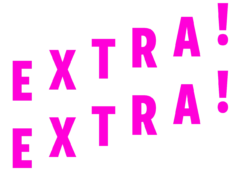by Chris Nash

Chris Nash was Professor of Journalism at Monash University, and previously Director of the Australian Centre for Independent Journalism at UTS.
In his third article on the convergence of art and journalism, Chris Nash examines the debate that followed the censorship of Haacke’s real estate works. This debate, about the nature of what activities can legitimately be regarded as art and the relationship of art institutions to those activities, is now even more loaded than it was fifty years ago, as artists increasingly work in social and media spaces rather than physical institutional spaces.
Guggenheim Director Thomas Messer set out in detail his concerns with Haacke’s work in a guest editorial for Arts Magazine in 1971, and made the link with journalism:
Where do we draw the line? With the revealed identities of private individuals and the clear intention to call their actions into question, and by a concomitant reduction of the work of art from its potential metaphoric level to a form of photo journalism concerned with topical statements rather than with symbolic expression. …. To the degree to which an artist deliberately pursues aims that lie beyond art, his very concentration upon ulterior ends stands in conflict with the intrinsic nature of the work as an end in itself. …. The tendency within this contradiction in the work itself transferred itself from it onto the museum environment and beyond it into society at large. Eventually the choice was between the acceptance of or rejection of an alien substance that had entered the art museum organisation. …. The incident at the Guggenheim Museum is, perhaps, the most dramatic among similar conflicts but by no means an isolated one. Parallel developments have occurred in other museums and more of the same may be predicted unless there is a change of attitude among artists as well as among museums.
Messer presented himself as drawing a set of defensive lines against “an alien substance” on behalf of the museum community and “society at large”, and for that reason alone, if not Haacke’s prominence in the wider artistic struggles of the time, the significance of the artworks has to be considered in the broadest socio-political context.
For his part, Haacke’s response to Messer’s action and arguments was plain and simple: the cancellation constituted an unacceptable act of censorship of an artist’s work. The subsequent development of his thinking and art made clear, however, that he well understood the profound insight that Messer had gifted to him – the response to a work of art can become an intrinsic part of the work’s meaning, and therefore artwork that addresses social systems might consider what future responses might be and how they might be anticipated, incorporated and contribute to the meaning of the work. The interplay between the present and the past and future is a constant factor in journalism, and after the Guggenheim experience Haacke frequently incorporated it into his art.

Hans Haacke
News (exhibition version), 1969/2008
At the time it was the sacked curator Edward Fry who most cogently articulated the significance of Haacke’s work. He set out his analysis in the essay he had written for the cancelled exhibition catalogue, which was subsequently published in Germany in 1972 and forty years later in the US in 2011. He was in no doubt about the significance of Haacke’s practice: “As a consequence of his efforts he, like every significant artist, has extended the limits of art and has forced the re-examination of both previous art and art theory.” In a perception that relates strongly not only to the fact/news value nexus in journalism, but also all attempts at empirical investigation in the natural sciences, Fry argued that the key to Haacke’s approach lay in his attempt to reveal through empirical evidence the invisible relations of force that produce the material and social world:
“In his search for the means to demonstrate the invisible but fundamental relations which underlie the nature of the world Haacke appears as far more a representational artist than many painters who, returning to traditional craft techniques and academic motifs, merely repeat old retinal habits of external representation.”
Haacke shared with fellow artists in the Art Workers Coalition (AWC) the radical critique of the role of art, artists and art institutions in modern societies:
“Coming at the end of a modern tradition in which art was relegated to a privileged but specialized and often highly esoteric social function, the approach to reality offered by Haacke acts not only as a severe critique of previous modern art, but also serves to eliminate arbitrary boundaries within our culture between art, science and society. Haacke’s way of representing the world offers an alternative to subjective limits as well, for he has consistently moved toward the elimination of ego as a guide to the apprehension of reality.”
The elimination of “arbitrary boundaries within our culture between art, science and society” occurs through the shift of the art/reality relationship away from symbolic representation to direct alignment. This was the rupture through which Haacke brought artistic practice into alignment with truth-seeking disciplines in the humanities and sciences (both physical and social) and with journalism. Empirical evidence or acts that are reported and incorporated into scientific research and into journalists’ reports remain facts in the world, even when they might have been produced as a result of the science or journalism itself, for example a laboratory experiment or an answer to a journalist’s question, a photo opportunity or a press release.
“As an artist, he is perhaps even more subversive than Duchamp, for Haacke so treats his own ready-mades that they remain systems representing themselves and therefore cannot be assimilated to art. Thus he violates the mythic function, to which art has long been assigned, of acting as a buffer between man (sic) and the nature of reality. His work instead presents a direct challenge, not only to the fatal but convenient bourgeois separation of art from life, but also to the related view that art functions as a symbolic transformation and interpretation of experience. Haacke’s world is rigorously materialist, not symbolic, but his materialist view is of such large dimensions and possesses a logic and truthfulness of such clarity that it reaches the level of an almost transcendental moral force: rather than setting limits to consciousness, he offers a new freedom.

Hans Haacke – Guggenheim Museum Visitors’ Profile, 1971 Questionnaire.
The complete and fundamental incompatibility between Messer’s and Fry’s views of art is stark. In 1997, art historian Alexander Alberro’s observed that the consecutive censorship of Buren and Haacke by the Guggenheim marked a victory for the forces of reaction in North American art institutions and the onset of “the new cultural conservatism”. But for other parts of the art world, including private galleries in New York and major international and European institutions, that was not the case, and Haacke continued to receive prestigious invitations and to mount challenging exhibitions. Shapolsky was exhibited in Milan the following January, and then in Rochester in upstate New York and a number of other galleries before inclusion in the Venice Biennale of 1978. Goldman trod a similar exhibition path. For Haacke, the actions by the Guggenheim and other institutions gave these social artworks a continuing life and systemic status comparable to the ongoing physical systems of the wind and water works. It was a major beachhead to secure in the exploration of art’s relationship to social reality, because of the link with journalism, revealing what needs to be considered in how we understand journalism in relation to social reality, and as a knowledge-producing practice.
